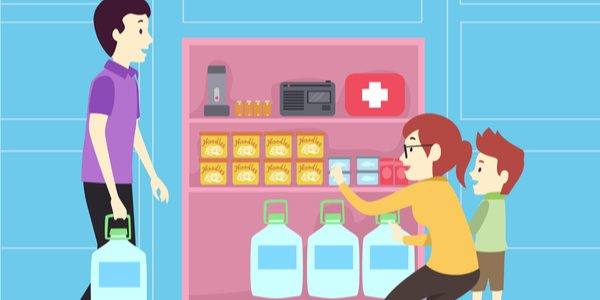
Just as it is important to partner with families for child care emergency preparedness, it is important to involve children as well. Even young children can learn about and help prepare for emergencies. Clear communication between adults and the children in their care is important to help children with emergency preparedness, response and recovery. Explanations and interactions should be developmentally appropriate, and adults should remain calm to help children remain calm.
Why should I include children in child care emergency preparedness planning?
When children are involved in child care emergency preparedness planning, they know what to expect, which can make it less scary. Having experience with practice drills can help children react appropriately if there is an actual emergency. Knowing there is a plan in place can also make them feel more secure.
How can I involve children in child care emergency preparedness planning?
There are many ways to let children take part in child care emergency preparedness planning.
For all children, including infants and toddlers:
- Provide regular practice drills.
- Speak in a calm, soothing voice during practice drills.
- Talk to them about what is happening during practice drills.
- Sing songs together to help reinforce emergency concepts and procedures.
- Expose children to the sensory relevant parts and pieces of preparedness, such as the “strobe” light and “alarm” sound of your program's fire alarm, and help them use calming strategies to support their acceptance of these.
- Create a program practice drill book and review with all children. Use actual pictures of elements of the drill, such as how you line up, where you exit, your gathering spot, etc.
- Invite first responders into the child care program to share information with children and learn about the equipment they might use in an emergency and to see them in full uniform (fire fighter gear may seem scary to some children).
Special considerations for infants and toddlers:
It can be a bit challenging to include young children in child care emergency preparedness planning, but it is possible. Child care providers should focus on positive interactions and relationships with infants and toddlers when it comes to helping them prepare for emergencies.
- Help them feel comforted during practice drills. Provide comfort items as appropriate.
- Read stories about weather.
- Use outdoor time to “test” the plans for evacuation. Plan reflection time with other educators and administrators in your program or your technical assistance coach.
- Send information home to families about your practice drills. Include how you “move” the children, what your practices are for emergency feeding (e.g., safely transporting breast milk, allergies, etc.).
For older children (preschool and older):
- Teach them ways to calm themselves.
- Explain the importance of practice drills in a way they understand.
- Have a discussion following each practice drill to talk about what went well and if there is anything you may want to do differently.
- Read stories about weather and emergency preparedness, response and recovery.
- Talk about natural disasters that may occur in your area (e.g., earthquakes, floods, hurricanes, severe storms, tornadoes, winter storms, etc.) and what to do if they happen.
- Use outdoor time and various temperatures and weather conditions to discuss reasons you have practice drills.
- Talk about what different emergency/disaster-related words mean.
- Let them help with assembling emergency supply kits.
- Ask them to choose items that will help keep them entertained while sheltering-in-place.
- Consider using tools like flashlights, smoke detectors and fire extinguishers in small group discussions and exploration.
- Do a “safety” walk in your child care home or facility and neighborhood to help children notice emergency exits, fire extinguishers, fire hydrants, emergency vehicles and other symbols of support in the event of a disaster.
- Have them review your evacuation routes to offer input.
- Provide materials for children to draw their evacuation route at home and at school.
- Connect information about weather conditions to the possibility of needing to shelter-in-place or evacuate.
- Provide writing materials, pictures and word cards so children can learn about the tools first responders may use.
- Consider a regular rotation of first responder costumes in your dramatic play center. Listen for their understanding of the process you practice.
- Make a “fire academy” training course on your playground. (Provide items such as hoses, costumes, pretend fire, etc., and allow them to role play different scenarios or participate in an obstacle course.)
- Encourage them to share information they learn about emergency preparedness with their families.
Putting it Into Practice
Choose some activities you can use to get children involved in your child care emergency preparedness. You can also think about ways you can incorporate children into the emergency preparedness planning you already do for your child care program.
Remember to keep your emergency preparedness activities involving children developmentally appropriate. Keep it light and fun to avoid scaring them. One of the most important things adults can do when talking to children about emergency preparedness (and during an emergency) is to stay calm.
Contact your local CCR&R if you would like to learn more about child care emergency preparedness, response and recovery.
If you use creative ways to involve children in your child care emergency preparedness planning, please let us know about them!
Resources
- Child Care Emergency Preparedness (CCAoA)
- Children and Youth Preparedness Social Media Toolkit (Ready.gov)
- Junior Fire Marshal Training Academy (The Hartford)
- Let’s Get Ready (Sesame Street in Communities)
- Prepare with Pedro (Ready.gov)
- Ready Kids (Ready.gov)
- Ready Wrigley (CDC)
- Teaching Kids About Emergency Preparedness (American Red Cross)
Blog Contributor: Carol Ayres: Early Care and Education Specialist, The Family Conservancy





